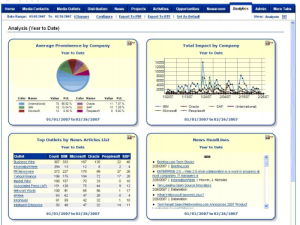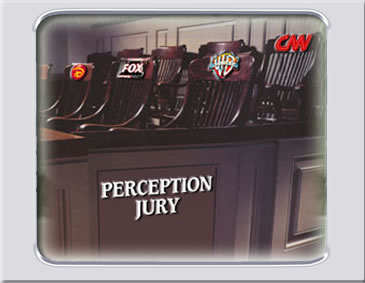 A sample of Cymfony's Brand Dashboard.[/caption]
A sample of Cymfony's Brand Dashboard.[/caption]I commemorated 9-11-2014 in a strange, improbable way. I met with the same guy I was scheduled to meet with 13 years earlier in the hopes of accepting my 9/11/01 consulting proposal. Like a lot of pre 9/11 plans this too was destined for the recycle bin. The best laid, evidence-based calculations lost their logic that day and remained speechless in deference to the victims of the alternately bright blue, pervasively dark morning.
I was holding some promising cards prior to that meeting. Earlier that summer I had joined up with a venture-funded search engine start-up called Cymfony. The company derived a lovely black box of algorithms that were based on what machines call "natural language" or how humans record their affairs. Computer scientists from the University of Buffalo had compiled code that consume large chunks of text and break them down into parts of speech that the software's creators called "grammars." The result was the ability to surface relationships and correlations lost to the more basic keyword matches and link associations that passed for relevancy in the Alta Vista search universe of the earliest 2000s.
The challenge for Cymfony was that there was no business model behind the search science. The leadership team called it "business intelligence" or BI. But to anyone outside of espionage circles that was a maturing market to tease the secrets out of spreadsheets for consolidating balance sheets and forecasting pipelines -- in effect BI was about the math of numbers -- not words.
Curiously I was working as a middle competitive intelligence manager for one of those BI firms when I got a call from Cymfony's CEO. Andrew Bernstein was recruiting potential test sites for building a proof of concept -- some evidence-based case studies they could use to springboard their go-to-market efforts. It was the fate of shifting economic fortunes that my interest in natural language search engines was peaking at the same time that my non-revenue-producing employment prospects were plummeting in the landing wreckage of the post dotcom nosedive.
Instead of trying to find the same work somewhere else I decided to pitch these Cymfony guys on a vision for sense-making that existed in the spreadsheets of analysts but nowhere on the results pages of Internet news searches -- let alone on the dashboards of influence-peddling news suppliers whose fortunes ride on those results. The opportunity as I explained to Andrew was that these guys are living from one traction-seeking distraction to the next. They put their fingers to the wind without any sense of how those winds are shifting or even taking shape within an overall news climate. Andrew found this compelling as a vision.
But the vision became the tangible game plan when he floated the idea of a media intelligence tool to an ally and image consultant who decried the need to quantify the squishy, personality-driven craft of branding management: not only who was flying higher or trending lower but where were the actual analytics to benchmark media coverage? Better still; quantify its impact on the segments carved out by the most visible agencies and advertisers.
Thus the Brand Dashboard was born and I was in the heady and somewhat awkward position of trying to carve out a role that was neither founder, developer, sales / marketing, or advisor / relationship-based. Besides helping to shape the new direction in the form of what the UX designer referred to as a "whiteboard doodle," I was the taxonomist -- the guy who could aggregate those grammars manifested in the black box so that the dashboard would contain the correct metrics for the right customer.
What I refused to see was that there were no ownership stakes for grammarians and taxonomists. I spent $2,000 on attorney fees to draft a contract that negotiated on those terms which never saw the light of its post 9/11 signature line. In retrospect I understand the basic flaws in my positioning as well as the resentments I carried well past the rejected proposal about having helped change the business model with no recognition by the business. I believe I turned down a pre IPO offer of preferred stock by Andrew. I was pissed and this was the most direct way I could maintain the dignity I could substitute in lieu of any parachute payments.
Thirteen years later I've earned my keep with as a taxonomist metadata mind. I don't run with my bedraggled tongue (where my sniffer should) be towards Silicon VC dollars. I support consulting organizations by making the knowledge donuts. That's meant a continuous cycle of SharePoint deployments and search configurations within the margins of firewalls and fixed budgets. There's no doubt it's for the best. Then again I've never met a change with no hand in changing that I didn't tailor into some kind of hidden blessing. There is no "all for the worst" in expression or in feeling when you outlive those blessed changes.
I've used the latest of these transitions to steer away from my functional headcount role as a knowledge manager to applying those tools of the trade into a more plausible business model -- doing KM work in a market-facing capacity as a content strategist. So who came to mind for testing my new content strategy idea? A series of incremental engagements I could sell to the same industry for which knowledge management is either a humbling confession of a knowledge problem, or at best, a necessary evil? An industry that gets no favors from Google in its quest for the right keyword campaigns and tends to view most marketing and design agencies with suspicion?
That's right. I dialed Andrew Bernstein up on LinkedIn. Andrew's still local to Boston and heading up Kearsarge Energy -- a project management firm that packages large solar farms for towns, municipalities, and large landowners. I asked him how it felt selling something more tangible these days than natural language-based branding barometers. He said the real liberation was the skeletal crew -- down from the hundred or so he managed at Cymfony before the first of two buy-outs.
The irony is that I goofed at the bargaining table of our last ill-fated meeting. I shoulda been making the donuts all along. It was a relief to admit that and positively cathartic to hear the 13 year response: “We could have used you.” That’s one winsome exchange that carries the lessons of the past over the boundaries of regret and a not-so-hidden blessing to commemorate this 9-11 Day.

